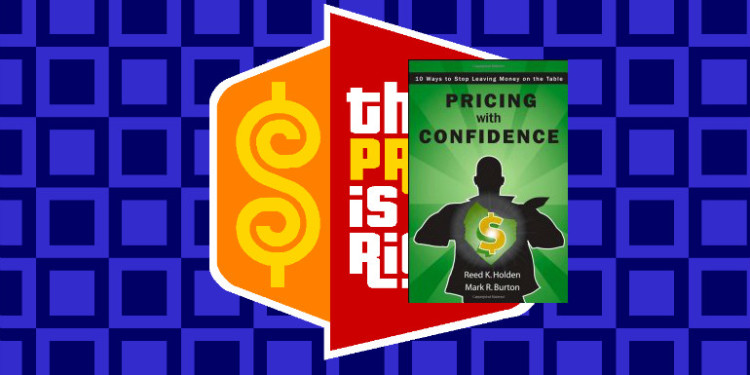Finding the right price

Pricing with Confidence by Reed Holden and Mark Burton
Pricing with Confidence lists ten rules for pricing strategy success. The first two, replacing the discounting habit with healthy arrogance about your value and understanding the value you provide to your customers, underpin the other eight. Since the first step to finding a solution to any problem is defining the problem, Holden and Burton begin with their diagnosis: an addiction to discounting. In order to replace this bad habit with a good one (a little over-confidence in your pricing strategy), you must understand the financial value you provide to your customers. Keys to success in these foundation steps are getting everyone in the organization to buy in to the shift in perspective, establish ground rules for acceptable discounting, gather a lot of data from your customers, learn to listen, and institutionalize customer discovery. Once you’ve gotten through these first two steps, you’re ready to pick a pricing strategy.
If you don’t have a well-defined pricing strategy, then who, specifically, is setting your prices?
Three types of pricing strategies
Skim pricing– Set prices high in comparison with the market average to maximize revenues from the upper end of the market. To be successful with skim pricing, your offering must be clearly differentiated from your competitors. In the early phases of the product lifecycle this strategy is possible because early adopters are willing to pay a premium price for access to new features. The effectiveness of skim pricing can decrease along the lifecycle as more competitors enter the market and differentiation diminishes.
History is littered with the wreckage of market leaders who carved out a position based on highly differentiated offerings and then left room at the low end of the market for second-tier competitors who ultimately unseated the leaders through a focus on moving into higher-value markets.
Neutral pricing – Use this strategy to take the spotlight off pricing by setting a price near the market average. Neutral pricing is often most effective in low growth markets.
Penetration pricing – To make price a key factor influencing buying decisions, price well below the average to gain market share. Because customers are encouraged to make decisions purely on price, penetration pricing can be challenging from a retention perspective. It is a difficult competitive advantage to maintain because without a technology edge, operationally superior competitors can decrease their prices more easily. To be successful with penetration pricing, you must build and use your capacity faster than competitors.
…many companies mistakenly believe they can use penetration pricing to grab share, achieve economies of scale, and thus create a preferential low-cost position. If it were that easy, everybody would be doing it.
Choosing a Pricing Strategy
There are several factors to consider when selecting a pricing strategy. These should be continually evaluated because changes in market conditions will impact your results.
- Value of your offering relative to competitors
- The lifecycle stage of your product
- Competitive dynamics
- Organizational consensus
The value of your offering relative to competitors
Your offering is higher value than your competitors
Highly differentiated: If your offering is highly differentiated, congratulations! You can choose any pricing strategy.
Not differentiated: If you are the market leader, choose a neutral-positive price. If you are not the market leader, then go the neutral route.
Your offering is high value, but the market is dominated by another company
In this case, stick with neutral pricing.
Your product or service is of lower value relative to your competitors
Choose a penetration or neutral-negative pricing strategy.
The Product Lifecycle
Pricing strategy should change throughout the product lifecycle. Introductory markets are characterized by slow sales growth while growth markets have, by definition, high rates of sales growth. During maturity, the growth rate slows and levels off. In decline, sales volumes decrease as customers move away to other offerings.
Introductory markets
During the early phase of market introduction, product companies are concerned with identifying and converting innovators and early adopters into referenceable customers. Early adopters are more interested in putting new technologies to use than price. Since there are relatively few early adopters and the market is inelastic, the best strategy here is skimming. Setting a high price initially creates a benchmark for future customers; moreover, early customers often use price as an indication of value.
Growth markets
In this phase, new customers are being added at high rate and existing customers are expanding their usage of products and services. Since this market phase is elastic, the authors suggest developing both high-end and low-end offerings. High-end customers will start to demand additional services and features so they can be served with new bundles of capabilities. Low-end customers must be acquired in order to maintain growth and deflect competitive entrants. Markets are elastic only in the growth phase so the pricing level is most effective there. Lowering prices will help gain market share at a time when pricing will influence sales volume.
Mature Markets
As demand levels off, penetration pricing loses its effectiveness because it frequently leads to pricing wars which erode profits for all players. Here again the authors recommend creating multiple offerings to cover multiple customer groups. For customers who want a complete solution, use skim pricing. Self-sufficient customers who are price sensitive will be best served by a low priced offering. Mainstream customers who have common needs should be offered a neutral price due to high volume and competitive presence. It’s important to recognize the move into a mature market and have a multi-pronged pricing strategy in place. Unbundling can help create multiple offerings to serve multiple customer segments.
Competitive Dynamics
Ask two questions in relation to competitive considerations for pricing: 1) what is your cost position relative to competitors?; and 2) what are the likely responses from competitors to pricing changes on your part?
A cost leader opponent cannot be easily overcome with penetration pricing. Likewise, a competitor intent on winning deals at any cost will not succumb to skim pricing. Burton and Holden suggest a neutral pricing strategy when faced with a volatile competitor.
An adaptive approach is best–market signals to watch include:
- Unit sales growth slows down and customers become less price responsive. This can signal the transition from the growth to maturity phase.
- Discounts no longer result in incremental volume. Change your strategy when price cuts increase but sales growth decreases.
- Competitors are introducing new offerings. If this means you have been displaced from a market leadership position, consider moving away from skim pricing.
- Lower cost competitors enter market. This can be the time to create a lower priced offering to protect your low-end market share.
- Your competitors fail to meet financial goals. They will likely become desperate to close deals and win business–it’s time to take the focus off price because you won’t win there.
To select your pricing strategy, focus on your customer demand, the value of your offering to your customers, where you are in the product lifecycle, and the competitive landscape. These factors will inform selection of one of the three basic pricing strategies.
Pricing with Confidence: 10 Ways to Stop Leaving Money on the Table







